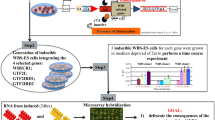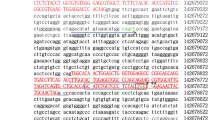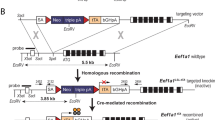Abstract
The gene IGF2, which encodes a fetal insulin-like growth factor, is imprinted, so only one of two parental copies of the gene is expressed. The altered expression of IGF2 has been implicated in Beckwith–Wiedemann syndrome, a human fetal overgrowth syndrome, which is characterized by overgrowth of several organs and an increased risk of developing childhood tumours. We have introduced Igf2 transgenes into the mouse genome by using embryonic stem cells, which leads to transactivation of the endogenous Igf2 gene. The consequent overexpression of Igf2 results in most of the symptoms of Beckwith–Wiedemann syndrome, including prenatal overgrowth, polyhydramnios, fetal and neonatal lethality, disproportionate organ overgrowth including tongue enlargement, and skeletal abnormalities. These phenotypes establish Igf2 overexpression as a key determinant of Beckwith–Wiedemann syndrome.
This is a preview of subscription content, access via your institution
Access options
Subscribe to this journal
Receive 51 print issues and online access
$199.00 per year
only $3.90 per issue
Buy this article
- Purchase on Springer Link
- Instant access to full article PDF
Prices may be subject to local taxes which are calculated during checkout






Similar content being viewed by others
References
De Chiara, T. M., Efstratiadis, A. & Robertson, E. J. Agrowth-deficiency phenotype in heterozygous mice carrying an insulin-like growth factor-II gene disrupted by targeting. Nature 345, 78–80 (1990).
DeChiara, T. M., Robertson, E. J. & Efstratiadiss, A. Parental imprinting of the mouse insulin-like growth factor-II gene. Cell 64, 849–859 (1991).
Reik, W. & Maher, E. R. Imprinting in clusters: lessons from Beckwith–Wiedemann syndrome. Trends Genet. 13, 330–334 (1997).
Leighton, P. A., Saam, J. R., Ingram, R. S., Stewart, C. L. & Tilghman, S. M. An enhancer deletion affects both H19 and IGF2 expression. Genes Dev. 9, 2079–2089 (1995).
Leighton, P. A., Ingram, R. S., Eggenschwiler, J., Efstratiadis, A. & Tilghman, S. M. Disruption of imprinting caused by deletion of the H19 region in mice. Nature 375, 34–39 (1995).
Ripoche, M. A., Kress, C., Pirier, F. & Dandolo, L. Deletion of the H19 transcription unit reveals the existence of a putative imprinting control element. Genes. Dev. 11, 1596–1604 (1997).
Sasaki, H. et al. Parental imprinting–potentially active chromatin of the repressed maternal allele of the mouse insulin-like growth factor-II (IGF2) gene. Genes Dev. 6, 1843–1856 (1992).
Feil, R., Walter, J., Allen, N. D. & Reik, W. Development control of allelic methylation in the imprinted mouse IGF2 and H19 genes. Development 120, 2933–2943 (1994).
Walter, J. et al. in Epigenetic Mechanisms of Gene Regulation(eds Russo, V. E. A., Martienssen, R. A. & Riggs, A. D.) 195–213 (Cold Spring Harbor Laboratory Press, NY, (1996)).
Ward, A. et al. Genomic regions regulating imprinting and insulin-like growth factor-II promoter 3 activity in transgenics: novel enhancer and silencer elements. Genes Funct. 1, 25–36 (1997).
Feinberg, A. P. Genomic imprinting and gene activation in cancer. Nature Genet. 4, 110–113 (1993).
Bates, P. et al. Mammary-cancer in transgenic mice expressing insulin-like growth-factor II (IGFII). Brit. J. Cancer 72, 1189–1193 (1995).
Christofori, G., Naik, P. & Hanahan, D. A. Asecond signal supplied by insulin-like growth factor II in oncogene-induced tumorigenesis. Nature 369, 414–418 (1994).
Rogler, C. E. et al. Altered body composition and increased frequency of diverse malignancies in insulin-like growth factor II transgenic mice. J. Biol. Chem. 269, 13779–13784 (1994).
Elliott, M. & Maher, E. R. Beckwith–Wiedemann syndrome. J. Med. Genet. 31, 560–564 (1994).
Weksberg, R., Shen, D. R., Fei, Y. L., Song, Q. L. & Squire, J. Disruption of insulin-like growth factor-II imprinting in Beckwith–Weidemann syndrome. Nature Genet. 5, 143–150 (1994).
Joyce, J. A. et al. Imprinting of Igf2 and H19: Lack of reciprocity in sporadic Beckwith–Wiedemann syndrome. Hum. Mol. Genet. 6, 1543–1548 (1997).
Reik, W. et al. Imprinting mutations in the Beckwith–Wiedemann syndrome suggested by an altered imprinting pattern in the IGF2–H19 domain. Hum. Mol. Genet. 4, 2379–2385 (1995).
Brown, K. W. et al. Imprinting mutation in the Beckwith-Wiedemann syndrome leads to biallelic IGF2 expression through an H19-independent pathway. Hum. Mol. Genet. 5, 2027–2032 (1996).
Lee, M. P., Hu, R. J., Johnson, L. A. & Feinberg, A. P. Human KvLQT1 gene shows tissue-specific imprinting and encompasses Beckwith–Wiedemann syndrome chromosomal rearrangements. Nature Genet. 15, 181–185 (1997).
Hatada, I. et al. An imprinted gene p57Kip2 is mutated in Beckwith–Wiedemann syndrome. Nature Genet. 14, 171–173 (1996).
Zhang, P. et al. Altered cell differentiation and proliferation in mice lacking p57Kip2 indicates a role in Beckwith–Wiedemann syndrome. Nature 387, 151–158 (1997).
Yan, Y., Frisén, J., Lee, M. H., Massagué, J. & Barbacid, M. Ablation of the CDK inhibitor p57Kip2 results in increased apoptosis and delayed differentiation during mouse development. Genes Dev. 11, 973–983 (1997).
Lau, M. M. H. et al. Loss of the imprinted IGF2/cation-independent mannose 6-phosphate receptor results in fetal overgrowth and perinatal lethality. Genes Dev. 8, 2953–2963 (1994).
Wang, Z. Q., Fun, M. R., Barlow, D. P. & Wagner, E. F. Regulation of embryonic growth and lysosomal targeting by the imprinted IGF2/MPR gene. Nature 372, 464–467 (1994).
Ludwig, T. et al. Mouse mutants lacking the type-2 IGF receptor (IGF2R) are rescued from perinatal lethality in IGF2 and IGF1R null backgrounds. Dev. Biol. 177, 517–535 (1996).
Ferguson-Smith, A. C., Cattanach, B. M., Barton, S. C., Beechey, C. V. & Surani, M. A. Embryological and molecular investigations of parental imprinting on mouse chromosome 7. Nature 351, 667–670 (1991).
Lee, J. E., Trantrahavi, U., Boyle, A. L. & Efstratiadiss, A. Parental imprinting of an IGF2 transgene. Mol. Reprod. Dev. 35, 382–390 (1993).
Hedborg, F., Holmgren, L., Sandstedt, B. & Ohlsson, R. The cell-type specific IGF2 expression during early human development correlates to the pattern of overgrowth and neoplasia in the Beckwith–Wiedemann syndrome. Am. J. Pathol. 145, 802–817 (1994).
Schneid, H. et al. Parental allele-specific methylation of the human insulin-like growth factor II gene and Beckwith–Wiedemann syndrome. J. Med. Genet. 30, 353–362 (1993).
Slatter, R. E. et al. Mosaic uniparental disomy in Beckwith–Wiedemann syndrome. J. Med. Genet. 31, 749–753 (1994).
Morison, I. M., Becroft, D. M., Taniguchi, T., Woods, C. G. & Reeve, A. E. Somatic overgrowth associated with overexpression of insulin-like growth factor II. Nature Med. 2, 311–316 (1996).
Pilia, G. et al. Mutations in GPC3, a glypican gene, cause the Simpson–Golabi–Behmel overgrowth syndrome. Nature Genet. 12, 241–247 (1996).
McLaughlin, K. J., Szabo, P., Haegel, H. & Mann, J. R. Mouse embryos with paternal duplication of an imprinted chromosome 7 region die at midgestation and lack placental spongiotrophoblast. Development 122, 265–270 (1996).
Shemer, R. et al. Dynamic methylation adjustment and counting as part of imprinting mechanisms. Proc. Natl Acad. Sci. USA 93, 6371–6376 (1996).
Hatada, I. et al. Aberrant methylation of an imprinted gene U2af1-rs1 caused by its own transgene. J. Biol. Chem. 272, 9120–9122 (1997).
Lee, J. T. & Jaenisch, R. Long-range cis effects of ectopic X-inactivation centres on a mouse autosome. Nature 386, 272–275 (1997).
Herzing, L. B. K., Romer, J. T., Horn, J. M. & Ashworth, A. Xist has properties of the X-chromosome inactivation centre. Nature 386, 272–275 (1997).
Sasaki, H. et al. Nucleotide sequence of a 28 kb mouse genomic region comprising the imprinted Igf2 gene. DNA Res. 3, 331–335 (1996).
Rotwein, P. & Hall, L. J. Evolution of insulin-like growth factor II: characterisation of the mouse Igf2 gene and identification of two pseudo-exons. DNA Cell Biol. 9, 725–735 (1990).
Sambrook, J., Fritsch, E. F. & Maniatis, T. Molecular Cloning: A Laboratory Manual(Cold Spring Harbor Laboratory Press, NY, (1989)).
Robertson, E. J. in Teratocarcinomas and Embryonic Stem Cells: A Practical Approach(ed. Robertson, E. J.) 71–112 (IRL, Oxford, (1987)).
Melton, D. A. et al. Efficient in vitro synthesis of biologically active RNA and RNA hybridization probes from plasmids containing a bacteriophage SP6 promoter. Nucleic Acids Res. 12, 7035–7056 (1984).
Ward, A. & Elliss, C. in The Insulin-like Growth Factors: Structure and Biological Functions(ed. Schofield, P.) 45–70 (Oxford Univ. Press, (1992)).
Acknowledgements
We thank D. Brown, J. Walter, J. Oswald, E. Maher, D. Hill, S. Fleming, J. Pell, A. Murrell and E. Grau for help and advice, and D. Styles, L. Notton and D. Powell for the preparation of manuscript and figures. This work is supported by Action Research, BBSRC, MRC and MAFF. G.K. is a senior fellow of the MRC.
Author information
Authors and Affiliations
Corresponding author
Rights and permissions
About this article
Cite this article
Sun, FL., Dean, W., Kelsey, G. et al. Transactivation of Igf2 in a mouse model of Beckwith–Wiedemann syndrome. Nature 389, 809–815 (1997). https://doi.org/10.1038/39797
Received:
Accepted:
Issue Date:
DOI: https://doi.org/10.1038/39797
This article is cited by
-
Transposable elements shape the evolution of mammalian development
Nature Reviews Genetics (2021)
-
MEG3-derived miR-493-5p overcomes the oncogenic feature of IGF2-miR-483 loss of imprinting in hepatic cancer cells
Cell Death & Disease (2019)
-
Bioprinting an Artificial Pancreas for Type 1 Diabetes
Current Diabetes Reports (2019)
-
IGF2 stimulates fetal growth in a sex- and organ-dependent manner
Pediatric Research (2018)
-
Genomic landscape of paediatric adrenocortical tumours
Nature Communications (2015)
Comments
By submitting a comment you agree to abide by our Terms and Community Guidelines. If you find something abusive or that does not comply with our terms or guidelines please flag it as inappropriate.



